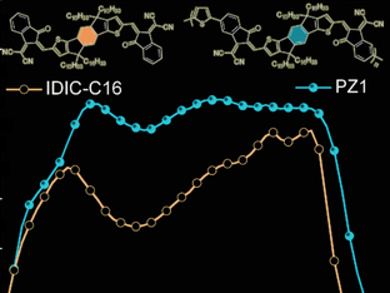All-polymer solar cells (all-PSCs) with a p-type conjugated polymer as the donor and an n-type conjugated polymer as the acceptor have attracted research attention because of their promising applications in flexible electronics. However, the weak absorbance of the polymer acceptors limits the power conversion efficiency (PCE) of such solar cells. n-Type organic semiconductors (n-OS) with an acceptor–donor–acceptor structure have shown high photovoltaic performance as acceptors in nonfullerene PSCs.
Zhi-Guo Zhang and Yongfang Li, Institute of Chemistry, Chinese Academy of Sciences, have developed a strategy to synthesize a high-performance polymer acceptor (PZ1) by embedding an n-OS building block into the polymer main chain. The n-OS units are bridged by thiophenes. This strategy combines the advantages of the n-OS acceptors (narrow bandgaps and strong absorptions) and the polymers (extended π-conjugation and better film-forming properties).
The polymer acceptor PZ1 shows higher thermal stability and red-shifted absorption (800 nm) than the corresponding monomer, and has a high absorption coefficient of 1.3·105 cm–1. PSCs made from a wide-bandgap polymer as the donor and PZ1 as the acceptor demonstrated a record high PCE of 9.19 %. The developed polymerization strategy is, thus, a new route to efficient polymer acceptors for all-PSCs.
- A New Strategy to Construct Low Bandgap Polymer Acceptor for High Performance All-Polymer Solar Cells,
Yongfang Li, Zhi-Guo Zhang, Yankang Yang, Jia Yao, Lingwei Xue, Shanshan Chen, Xiaojun Li, William Morrison, Changduk Yang,
Angew. Chem. Int. Ed. 2017.
DOI: 10.1002/anie.201707678


